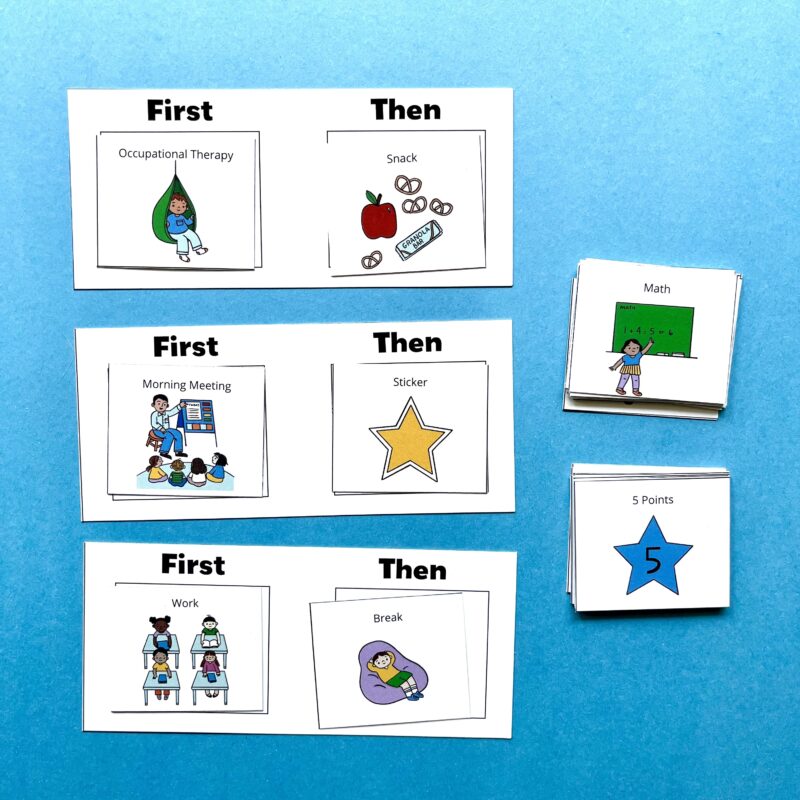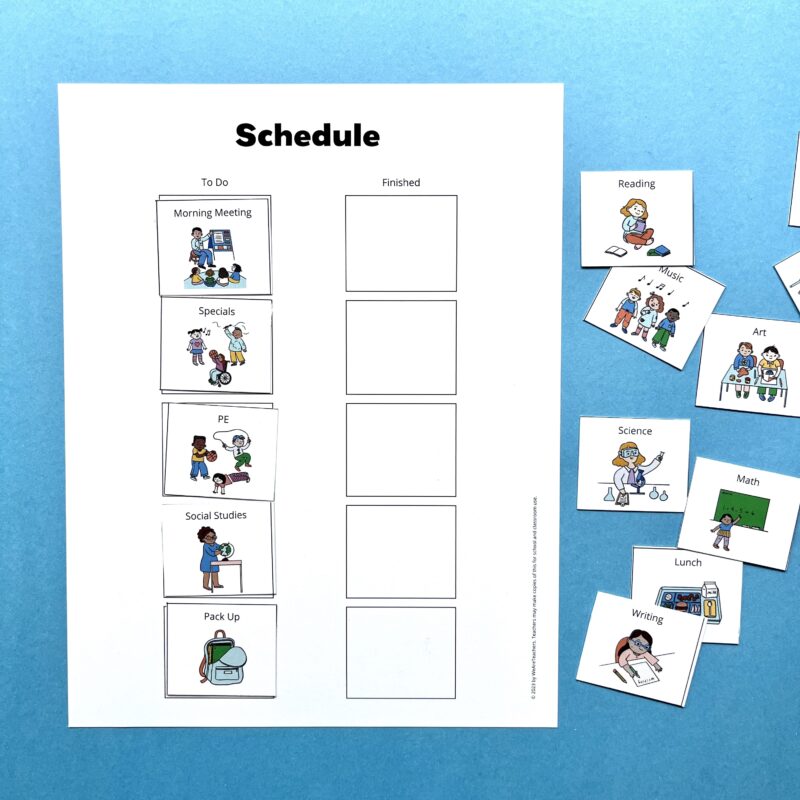A visual schedule sounds easy enough—a schedule with pictures. But it’s more than that. A visual schedule is meant to communicate where a child should be throughout the day or what a child should be doing. They are also meant to be an individualized tool that students learn to manage by themselves.
We created a bundle of five free printable visual schedule templates, including a daily schedule, work and reward board, daily routine, first-then board, and binder schedule. Just submit your email to get them all! Plus read on for more info about how to use your visual schedules.
Who needs a visual schedule?
Visual schedules are typically for kids who are autistic, have ADHD, have developmental delays, or who process visual information easier than auditory or written information. A visual schedule is a very specific accommodation and will typically be recommended for a student based on an MTSS or IEP team’s decision.
Read more: What Is MTSS?
Read more: What Is Special Education?
How do visual schedules help autistic kids?
For autistic kids, who often have strengths processing visual information and deficits processing auditory information, visual schedules provide a quick way to see where they are supposed to be or what they are supposed to be doing.
For autistic kids, visual schedules:
- Increase understanding through the use of images
- Provide predictability and routine
- Communicate changes in routine in a familiar way
- Help students understand what is expected of them without having to rely on verbal directions
- Provide some control over their schedule as they move the image from “to do” to “done”
- Generate independence as they learn to manage the visual schedule themselves
The ultimate goal of a visual schedule is that the student learns to manage it themselves. So, at the start of the year, you’ll be teaching and reinforcing the routines and images, but in winter and spring, start handing over the task of managing the visual schedule to the student.
How do visual schedules help kids with ADHD?
For kids with ADHD, who may struggle with executive functioning and processing verbal directions, visual schedules can:
- Provide organization for their day or an activity
- Help them know what’s expected of them
- Reduce stress around transitioning from one activity to another
- Reduce behavior concerns related to understanding what is expected of them
How do I use visual schedules?
We’ve provided five different versions of visual schedules that you can download and use with students in your classroom.
Daily Schedule

WeAreTeachers
Use this visual schedule to help a child move through their entire school day. Post the schedule in a place that’s accessible, like on the side of your whiteboard or on their desk. Then, model and teach the student how to move each image from “to do” to “all done” as you move through your day.
Tip: The images in the visual schedule should be of where the student should be rather than what they are presently doing. For example, an image of the carpet rather than of morning meeting. The focus is on helping the student know where to be and when throughout the day.
Work and Reward Board

WeAreTeachers
Use this visual schedule to show a student what they have to do to work for a reward. This is designed to move with the student as they go throughout their day. So, you can put it at their desk and place the three things they have to do (read, write, read) before they earn their reward. When implementing this visual schedule, it can be helpful to have the student select their reward, and take off the “to dos” as they go. Also, make sure to keep the tasks manageable. A student that can work for five minutes will need three tasks they can do in the span of five minutes to earn a reward, while a student who can work for an entire block will need images that equate to longer amounts of time.
Daily Routine

WeAreTeachers
A daily routine visual schedule helps students who need reminders at arrival and dismissal. Post this near the student’s cubby or desk to help them work through the daily routine independently.
First-Then Board

WeAreTeachers
A First-Then board shows a student what they are doing, in order and in manageable chunks. You could use a First-Then board with a small group of students to show them that they are going to do writing first, then break. Or you could provide each student their own First-Then board to help them manage their individual work.
Binder Schedule

WeAreTeachers
A visual schedule that fits into a binder can help older students who move from class to class and need a visual reminder of where to go next. Or it can go into a work binder to show students how to move through a block of time, like literacy block.
How do I assemble my printable visual schedules?
Get ready to cut and laminate!
- Print out the schedule you need.
- Use the images we provided or pull your own from photos of your classroom and students.
- Laminate the images.
- Add Velcro on the back.
- Post the schedule where your student can access it. For example, you may put the schedule at the student’s desk, or you may have it in a binder that they refer to after every lesson.

